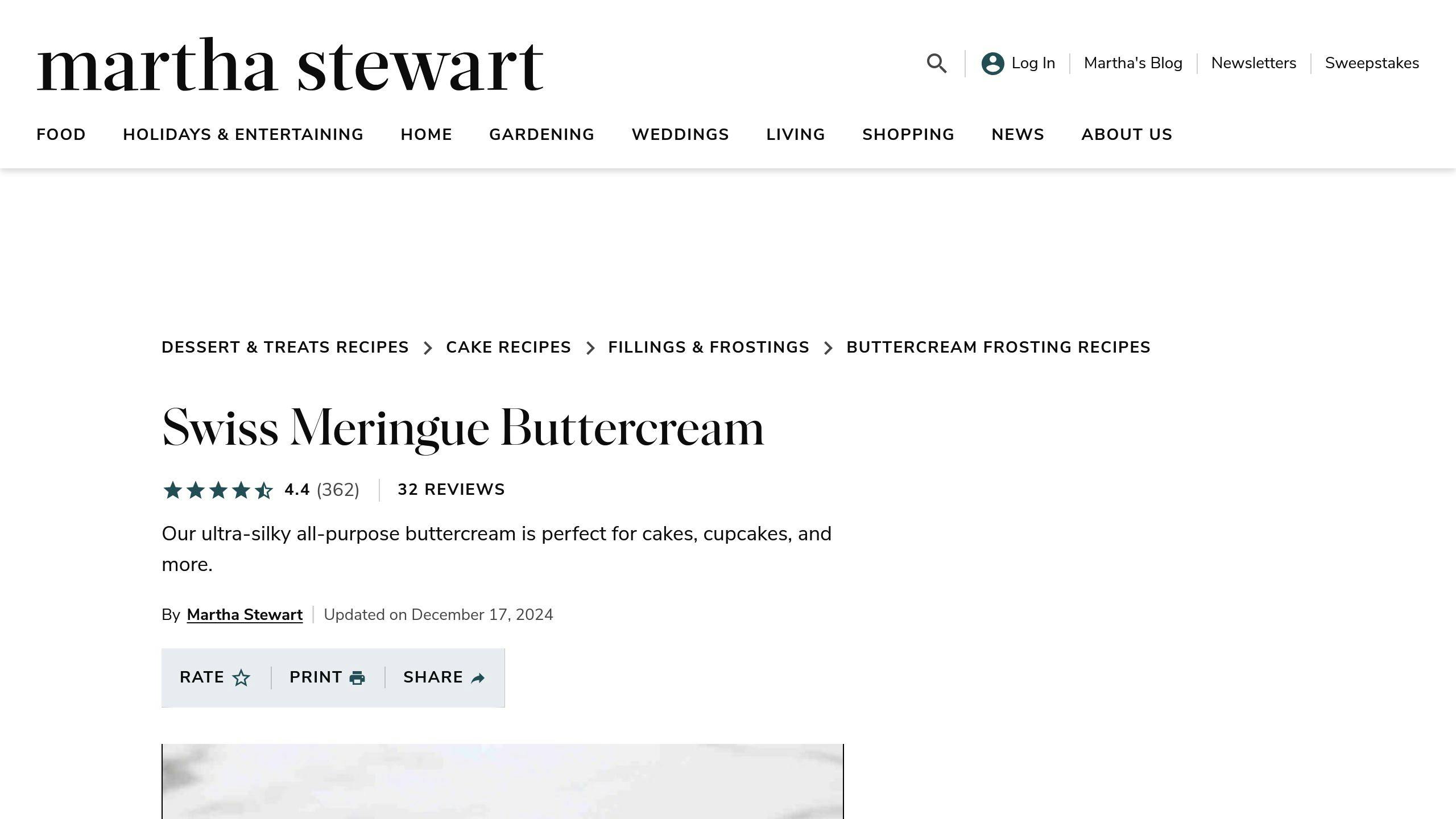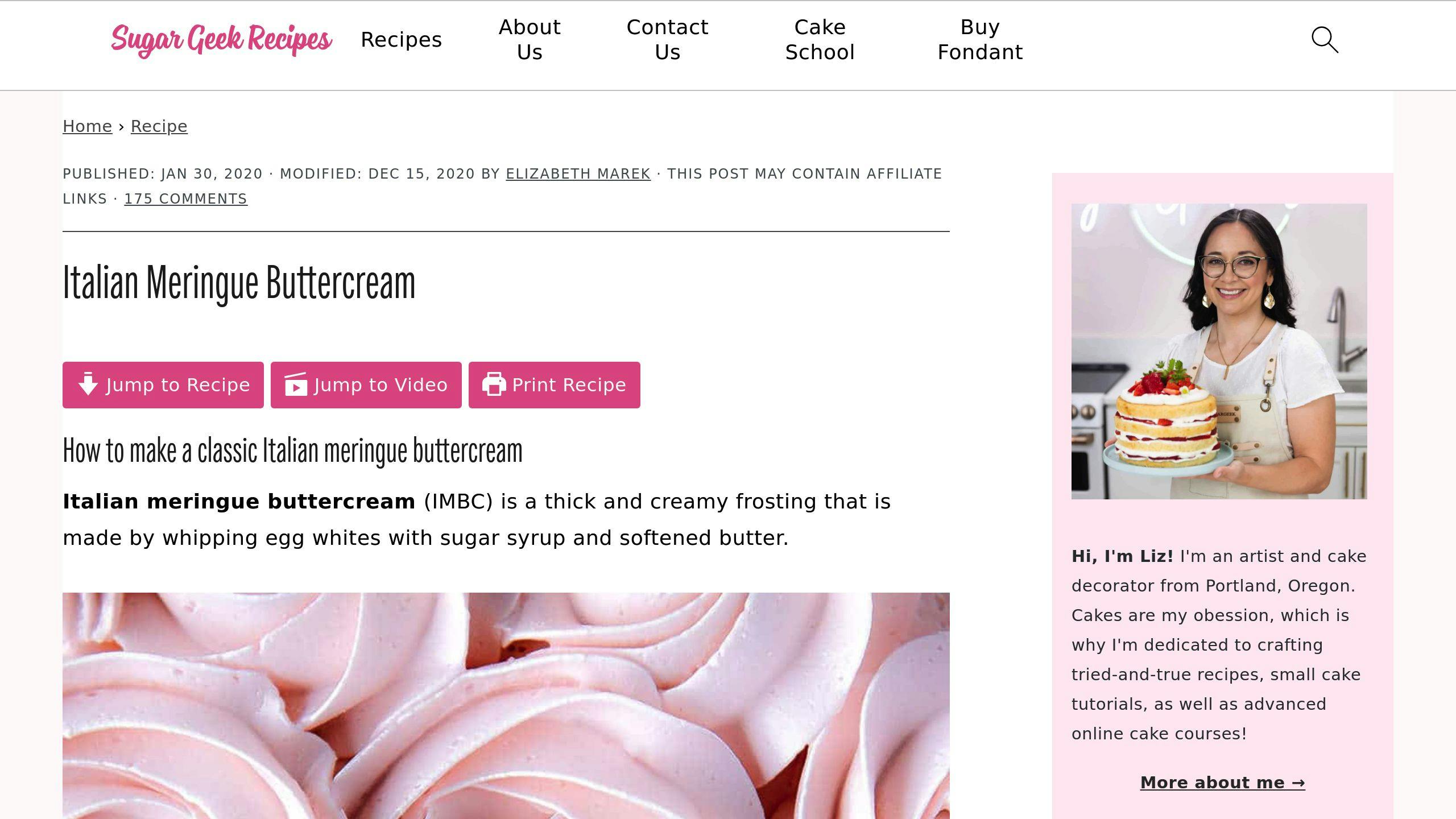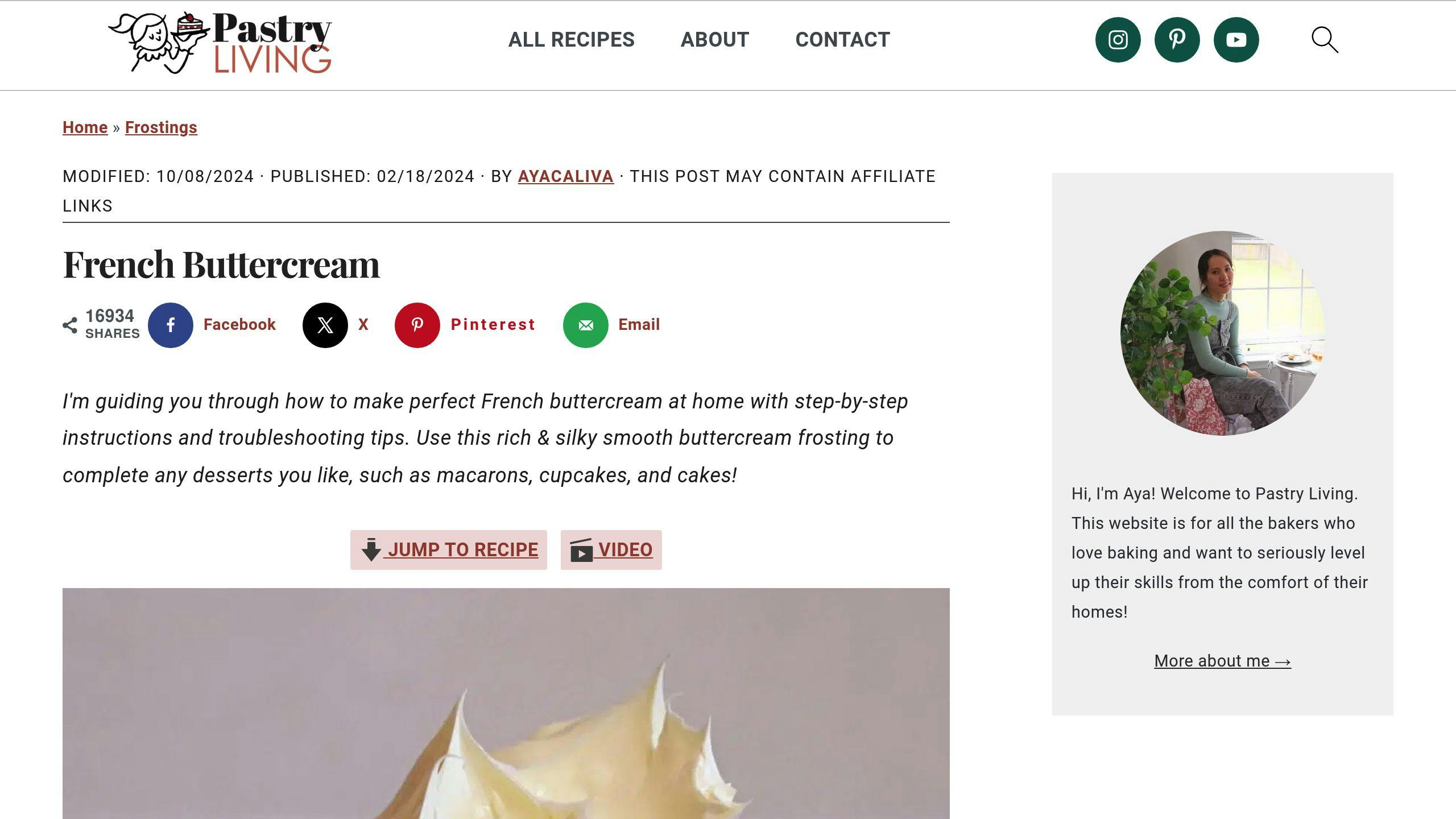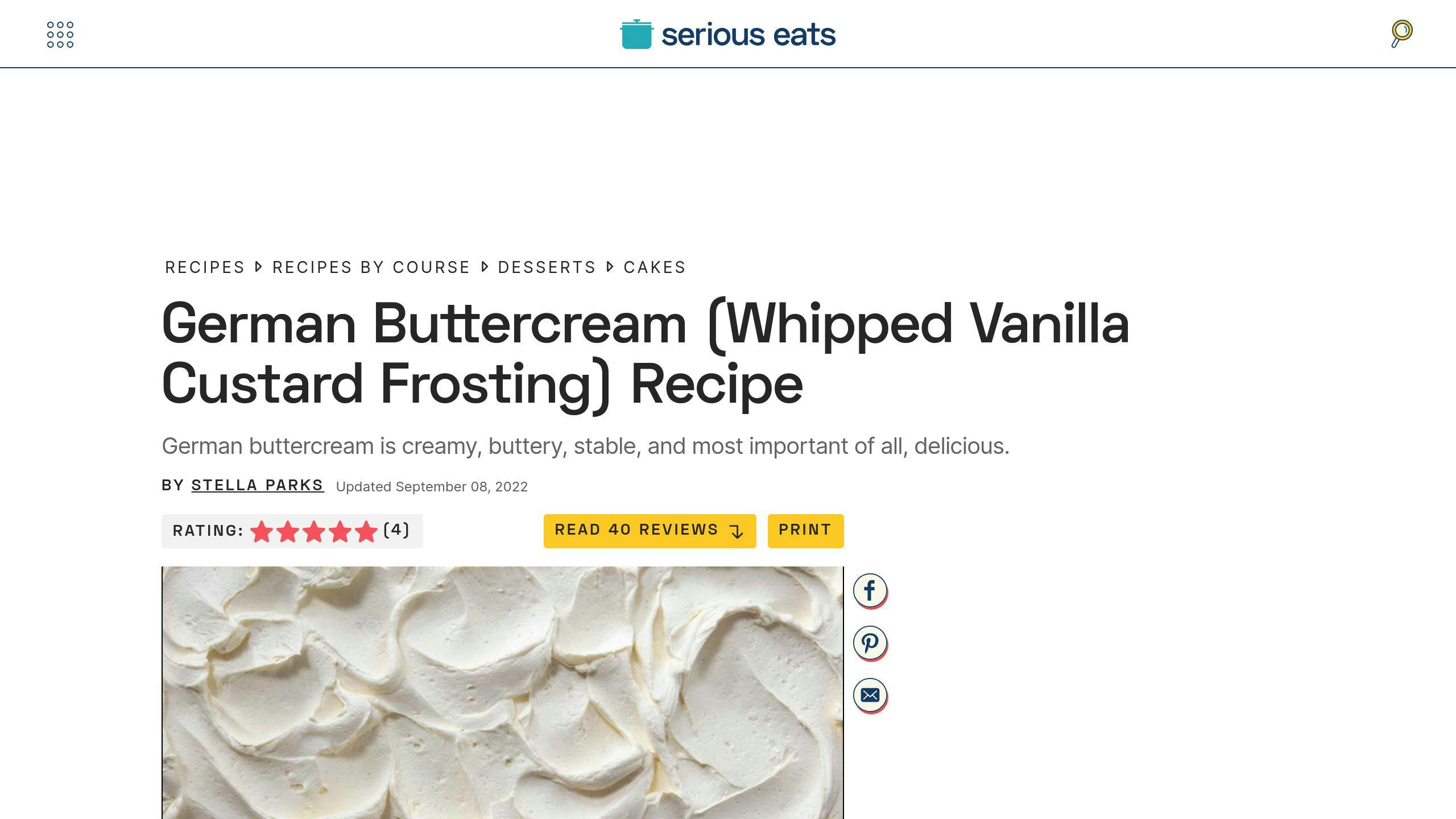Buttercream is essential for cake decorating, offering both flavor and structure. Here's a quick guide to the six most popular types, their key traits, and best uses:
- American Buttercream: Sweet, easy to make, great for simple designs. Best for casual cakes and piping.
- Swiss Meringue Buttercream: Silky, less sweet, ideal for smooth finishes and wedding cakes.
- Italian Meringue Buttercream: Firm, heat-resistant, perfect for intricate designs and outdoor events.
- French Buttercream: Rich, custard-like, great for luxury cakes and indoor celebrations.
- German Buttercream: Custard-based, creamy, excellent for layered cakes and subtle flavors.
- Whipped Buttercream: Light, airy, best for soft designs and quick projects.
Quick Comparison
| Buttercream Type | Texture | Sweetness | Best For | Temperature Stability |
|---|---|---|---|---|
| American | Sweet, creamy | Very sweet | Casual cakes, piping | Up to 70°F |
| Swiss Meringue | Silky smooth | Mild | Wedding cakes, smooth finishes | Up to 80°F |
| Italian Meringue | Firm, stable | Mild | Intricate designs, outdoor use | Up to 85°F |
| French | Custard-like | Less sweet | Luxury cakes, indoor events | Up to 75°F |
| German | Creamy, smooth | Balanced | Layered cakes, subtle flavors | Up to 80°F |
| Whipped | Light, airy | Mild | Simple designs, quick projects | Below 75°F |
Choose based on your design, environment, and skill level. Continue reading for detailed recipes and tips to master each type!
The ultimate buttercream comparison
1. American Buttercream
American buttercream is a go-to frosting for cake decorating. It's made with just a few ingredients: butter, powdered sugar, and a splash of cream or milk. The result is a rich and creamy frosting that's easy to work with.
You can tweak the consistency by adjusting the amounts of powdered sugar and liquid. For detailed piping work, opt for a stiffer mix. If you're aiming for a smooth cake surface, go for a slightly softer texture.
Temperature is key when working with this frosting. The sweet spot is between 70-75°F (21-24°C). If it's too warm, the buttercream may become too soft and lose its shape.
| Climate | Adjustment | Result |
|---|---|---|
| Hot & Humid | Add powdered sugar | More stability |
| Cold & Dry | Add cream | Easier to spread |
| Room Temp | Use standard recipe | Perfect consistency |
For the best results, use butter at room temperature and sift the powdered sugar. Beat the mixture until it's light and fluffy. This extra step ensures a smooth texture that's simple to handle.
American buttercream is known for its sweetness and its ability to form a slight crust when exposed to air. That crust can be an advantage for creating decorations like flowers and borders.
It's also easy to customize. Add vanilla for a classic flavor or mix in food coloring for themed designs. Just be cautious with liquid flavorings to avoid altering the consistency.
You can store it at room temperature for up to 2 days or refrigerate it for 2 weeks. If you refrigerate, re-whip it before using to restore its texture. This makes it a practical choice for preparing ahead of time, especially for larger cake projects.
While American buttercream is a popular and versatile choice, Swiss meringue buttercream is another option to consider if you're looking for a smoother, less sweet frosting for more sophisticated designs.
2. Swiss Meringue Buttercream

Swiss Meringue Buttercream (SMBC) is a go-to choice for professional decorators thanks to its smooth texture, balanced sweetness, and ability to hold its shape. Unlike American buttercream, SMBC offers a less sugary taste and a polished finish, making it perfect for elegant and detailed designs.
To make SMBC, you’ll need to heat egg whites and sugar to 160°F using a double boiler. Once heated, whip the mixture to stiff peaks before gradually incorporating room-temperature butter.
| Feature | Advantage | Ideal For |
|---|---|---|
| Silky Texture | Smooth finish | Wedding cakes |
| Balanced Sweetness | Not overly sweet | Formal events |
| Heat Stability | Keeps its shape | Outdoor gatherings |
| Light & Airy | Easy to spread | Detailed designs |
SMBC is excellent for creating intricate decorations like lace patterns or lifelike flowers. Its smooth consistency is perfect for achieving sharp edges, clean lines, and modern geometric designs. This makes it especially suited for tiered cakes meant to impress.
For the best results, keep your workspace between 68-72°F (20-22°C). In humid conditions, refrigerate the buttercream briefly before piping to help it hold its structure.
Pay attention to the details during preparation. Add butter gradually in small cubes, and make sure all ingredients are at room temperature to avoid issues with the emulsion. Adding butter too quickly or using cold ingredients can lead to a broken texture.
You can store SMBC in the fridge for up to two weeks or freeze it for three months. When ready to use, let it come to room temperature and re-whip until smooth.
Professional decorators love SMBC for its ability to create sharp edges and intricate designs, making it a top choice for multi-tiered wedding cakes. If you need a buttercream with even more firmness and stability, consider trying Italian Meringue Buttercream.
3. Italian Meringue Buttercream

Italian Meringue Buttercream (IMBC) is known for being the most stable option among meringue-based buttercreams. Its smooth, silky texture is achieved by pouring hot sugar syrup (heated to 235-240°F, also known as the soft ball stage) into whipped egg whites. This process creates a glossy meringue, which is then combined with butter to form the buttercream.
Thanks to its pasteurized egg whites, IMBC holds its shape well, even in warmer conditions. It can withstand temperatures up to 85°F, making it a go-to choice for summer weddings or outdoor celebrations.
| Characteristic | Details | Best Used For |
|---|---|---|
| Texture | Silky smooth, very stable | Intricate piping work |
| Sweetness Level | Mild and balanced | Elegant celebrations |
| Temperature Resistance | Excellent (up to 85°F) | Outdoor events |
| Storage Life | 1 week refrigerated | Multi-day projects |
While it requires more skill than Swiss Meringue Buttercream, the payoff is worth it. Using room-temperature egg whites enhances both stability and texture. Keep your workspace at room temperature, and use unsalted butter that’s slightly cool yet soft enough to work with. Gradually add the butter, ensuring each piece is fully mixed in before adding more.
IMBC takes food coloring exceptionally well, but for the best results, add the coloring after the buttercream is fully mixed and slightly cooled. This step ensures vibrant colors without compromising texture. To store, seal it in an airtight container, and re-whip it at room temperature for a flawless finish.
This buttercream is perfect for creating detailed designs like ruffles and roses. Its non-crusting nature allows for smooth finishes that stay intact throughout your event. If you’re looking for something richer and more indulgent, consider French Buttercream as an alternative.
4. French Buttercream

French Buttercream, also known as pâte à bombe, is the richest of all buttercream types. Its key ingredient? Egg yolks. This gives it an ultra-smooth, velvety texture that practically melts in your mouth. To make it, sugar syrup is heated to 240°F and slowly poured into whipped egg yolks, creating a stable emulsion that serves as the base for this indulgent frosting.
| Characteristic | Details | Best Used For |
|---|---|---|
| Texture | Ultra-smooth, velvety | Luxury cakes |
| Sweetness Level | Less sweet, custard-like | High-end designs |
| Temperature Resistance | Moderate (up to 75°F) | Indoor events |
| Storage Life | 5 days refrigerated | Short-term projects |
The secret to its creamy consistency lies in slowly adding room-temperature butter to the mixture. French Buttercream is ideal for achieving sleek cake surfaces and intricate piping, making it a popular choice for upscale events where elegance and refined taste take center stage. However, its egg yolk base means it's best suited for indoor or climate-controlled settings.
This buttercream is highly adaptable to different flavors while retaining its luxurious texture. Its rich, refined taste has made it a go-to for professional pastry chefs crafting wedding cakes and detailed designs for high-end occasions. Be sure to store it in the fridge and re-whip before using to restore its smoothness.
Looking for something lighter but still custard-based? Try German Buttercream for a different take.
sbb-itb-529d1c3
5. German Buttercream

German buttercream, sometimes called crème pâtissière buttercream, blends the creamy texture of custard with the smoothness of buttercream. Unlike French buttercream, which relies on egg yolks, this version uses a fully cooked custard base, creating a firmer texture and a silky finish.
| Characteristic | Details | Best Used For |
|---|---|---|
| Texture | Silky, custard-like | Smooth finishes |
| Sweetness Level | Moderate, balanced | Traditional cakes |
| Temperature Resistance | Good (up to 80°F) | Outdoor events |
| Storage Life | 7 days refrigerated | Medium-term projects |
The custard base makes it easy to apply smoothly and offers better structure compared to basic butter-sugar mixtures. To avoid air pockets, use a paddle attachment when mixing, and let the custard cool to room temperature before adding butter for the right consistency.
For the best results, keep your workspace between 68-75°F (20-24°C). German buttercream combines the rich, custard-like quality of French buttercream with added stability, making it a dependable choice for cakes in moderate climates or semi-outdoor events.
This buttercream works well with added flavors like chocolate or fruit purees without compromising its structure. It's a great option for wedding cakes and other special occasions where a smooth, stable finish is important.
Store it in the refrigerator for up to 7 days, and re-whip before using. While German buttercream is known for its smoothness and stability, decorators looking for a lighter texture might prefer Whipped Buttercream as an alternative.
6. Whipped Buttercream
Whipped buttercream is the lightest and fluffiest option among buttercream types, perfect for decorators who value simplicity and a soft texture over detailed or long-lasting designs. Made with heavy cream and butter, it delivers a cloud-like finish.
| Characteristic | Details | Best Used For |
|---|---|---|
| Texture | Light, airy, cloud-like | Simple decorations |
| Sweetness Level | Mild to moderate | Light sponge cakes |
| Temperature Resistance | Low (below 75°F) | Indoor events |
| Storage Life | 24 hours refrigerated | Same-day projects |
This buttercream's biggest selling point? It's easy to make. Unlike Swiss or Italian meringue buttercream, it doesn’t require cooking, making it great for beginners or anyone short on time. That said, it does need careful handling - temperature and whipping technique are key to avoiding separation or a gritty texture.
Keep your workspace cool (below 75°F or 24°C) and use chilled tools to maintain its consistency. It shines in controlled indoor settings, so it’s a go-to for occasions like birthday parties or casual gatherings where the frosting will be served immediately.
For storage, refrigerate for up to 24 hours and re-whip before using. If you want to add food coloring or flavor extracts like vanilla or almond, mix them in gradually during the final whipping stage. This helps maintain the frosting’s smooth texture and ensures the color or flavor is evenly distributed.
When decorating, whipped buttercream is ideal for creating soft peaks, rosettes, or simple piped borders. Its light texture pairs beautifully with delicate sponge cakes and fruit-filled desserts, enhancing their flavors without overpowering them.
For decorators who need more structure or durability, though, other buttercream options might be a better fit. Whipped buttercream is best suited for casual, light designs where its airy texture can truly shine.
Comparison Table
Here's a side-by-side look at six popular buttercream types to help you decide which one fits your cake decorating needs. We've broken down the key factors that influence texture, preparation, and performance.
| Buttercream Type | Texture | Preparation Difficulty | Temperature Stability | Best Uses | Working Time |
|---|---|---|---|---|---|
| American | Sweet, creamy | Easy (15-20 mins) | Up to 70°F | Simple piping, casual cakes | 2-3 hours at room temp |
| Swiss Meringue | Silky smooth | Moderate (45-60 mins) | Up to 80°F | Smooth finishes, wedding cakes | 4-6 hours at room temp |
| Italian Meringue | Rich, firm | Advanced (60+ mins) | Up to 85°F | Intricate designs, tiered cakes | 6-8 hours at room temp |
| French | Custard-like | Advanced (60+ mins) | Up to 75°F | Rich fillings, elegant finishes | 3-4 hours at room temp |
| German | Light, creamy | Moderate (90+ mins) | Up to 72°F | Subtle flavors, layer cakes | 2-3 hours at room temp |
| Whipped | Airy, fluffy | Easy (20-30 mins) | Below 75°F | Simple decorations, quick projects | 1-2 hours at room temp |
Italian Meringue Buttercream stands out for its heat resistance, holding up well in temperatures as high as 85°F. On the other hand, Whipped Buttercream, while light and fluffy, is less stable and best for quick, simple projects.
For decorators aiming for smooth finishes or intricate designs, Swiss and Italian Meringue Buttercreams are excellent choices. Swiss Meringue Buttercream is especially loved for its silky texture, making it great for precise piping. Meanwhile, Whipped Buttercream works well for casual, low-effort decorations.
When choosing a buttercream, think about the environment you'll be working in and the complexity of your design. Each type has its strengths, so as you gain experience, you'll discover which one suits your projects best. Whether you're making a simple birthday cake or a show-stopping wedding centerpiece, there's a buttercream for every occasion.
Choosing the Right Buttercream
When deciding on the best buttercream for your project, it’s all about balancing your needs with the strengths of each type. Swiss and Italian Meringue Buttercreams are popular among professionals, prized for their stability and ability to handle detailed designs.
If you're just starting out, American Buttercream is a great choice. It’s simple, quick to make, and perfect for casual designs. However, if you're working in warmer conditions (above 70°F), switching to Swiss or Italian Meringue Buttercream can provide better stability.
For those looking for richer and more distinct flavors, French and German Buttercreams are excellent options. French Buttercream, with its custard base, works beautifully as a filling, while German Buttercream pairs well with layered cakes that call for a more delicate flavor.
The key to success lies in matching the buttercream to your environment, design complexity, and time constraints. Swiss and Italian Meringue Buttercreams shine in intricate designs due to their longer working time and durability.
Experimenting with small batches can help you understand how each buttercream behaves. Over time, you’ll get a feel for which one complements your decorating style and specific project needs.
Whether it’s a simple birthday cake or an elaborate wedding centerpiece, these buttercream recipes can help you achieve stunning results. With practice and an understanding of each type, you’ll be ready to tackle any cake design with confidence.
FAQs
What type of buttercream is best for decorating?
For professional decorating, Swiss Meringue Buttercream (SMBC) is a top choice. Its smooth texture and reliable stability make it ideal for intricate designs and clean finishes, especially in temperatures up to 70°F. If you're working in warmer conditions, Italian Meringue Buttercream (IMBC) is a great alternative. It shares SMBC's smoothness but offers better heat resistance, making it suitable for longer display times.
For beginners or casual decorators, American Buttercream is a go-to option. It's easy to make and requires less time, though it doesn't provide the same level of refinement as meringue-based buttercreams. It’s perfect for simple designs and straightforward decorating tasks.
When choosing your buttercream, keep these factors in mind:
- The complexity of your design
- Temperature and how long the cake will be displayed
- Your skill level and time constraints
- The tools and ingredients you have available
No matter which type you choose, proper temperature control and precise measurements are key. Using room-temperature ingredients and focusing on technique will help you achieve great results.
The "best" buttercream really depends on your needs, environment, and experience. For more details on each type, check the sections above.


